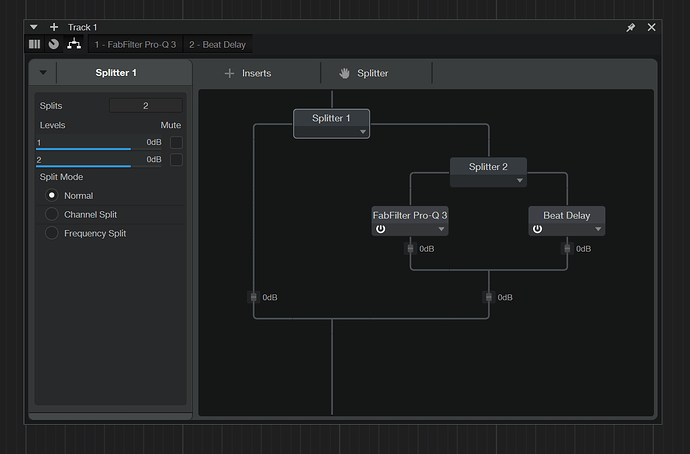But those are not seperate things. 100% wet implies 0% dry and vice versa.
Of course they are separate, just look at convolver, cabinet sim or whatever, they have a wet slider and a dry slider for a reason you know.
You can have 90% wet and 80% dry, but if it was only one slider like you suggest the dry would automatically be 10%. That is not practical.

Okay, then we also need the following in Renoise:
-
A No-Send device
-
An unmute button
-
An unsolo button
And the EQ should have the option to boost AND reduce volume for each point individually.
That’s just a very weird way to say 53% wet (on anormal single knob).
Math genius here: two sliders can sum up to 200%, while a single knob always stays 100%. Hence you can compensate with additional gain or so, if using single knob solution, to get fancy 200%.
Either you don’t understand or you don’t want to understand, i don’t know, but you see the difference don’t you? Ok, you could fiddle with a gainer after the slider to compensate for the level changes you would get by sliding the single wet/dry slider compared to sliding only one of the separated sliders, but that would imo opinion not be very practical.
I think the idea of single knob is to “preserve overall volume”, but actually it is not working, since 100% reverb might not sound equal loud as 100% dry…? Still I think single knob is more common. Dual knob surely is more flexible for a lot of scenarios, but wastes one knob slot. In the end I think single knob is better, it saves space.
But the ableton / bitwig parallel container anyway provides individual gain per layer + overall dry/wet single knob, or was it wet gain in Bitwig? Maybe the overall knob could be saved, and instead there was a dry layer by default, which you then can gain as you want. But such a device may require new gui controls in Renoise… And horizontal scroller inside a dsp GUI…
The point I wanted to make is that I have never encountered a situation in practice where two knobs would have been superior, in the same way that having individual boost and cut on an EQ would not be practical.
But anyway, the forum software just told me that I have responded too often to you already in this thread (what a weird “feature”), so I’m out 
I have very good use of the wet and dry sliders that many of the native dsp’s have, it’s so much easier to automate. Say you want a gated reverb on your snare, but you don’t want to change the dry levels.
I think just adding wet/dry control to the doofer isn’t suitable. It is also about calculating possible PDC per layer, and then compensating all layers to the maximum PDC. If you want to use multiple layers, you would have to stack the doofers recursively, and then it seems not to be possible to me to properly calculating parallel PDC anymore, it instead will sum up, so not just the maximum. Also then the whole dry/wet thing seems to be fucked up.
even this is a pain in the ass compared to just a quick w/d knob… atleast it’s possible, though
I’d be fine with either a single wet/dry knob/slider or 2 separate ones. If this was standard on all DSP effects, either way would be awesome!! 
doofer dry/wet yes please
If I had one wish for a new feature in Renoise, it would be this, frankly. It would open up a world of possibilities for the use of Doofers (and native effects in general). I, for example, play a lot of guitar through renoise lately and I’m trying to get away from using too many plugins and instead build some simple effects (e.g. Tremolo, Wah etc.) with native devices only - Doofers are in theory great for that, but the lack of a possibility to set Wet/Dry signal is really limiting. I hope this is still somewhere on taktik’s list ![]()
+1
Doofer wet/dry, modulation input/output, and internal/parallel fx chains are sorely lacking relative to other daw’s functionality… These few changes would be huge and would add massively to native sound sculpting potential in stock renoise.
@taktik, any comment on the possibility of this as a feature development priority?
This was a bad idea and I revoke it. This case would better be covered by something that allows splitting the signal. (I’m not sure if that’s what people refer to as “parallel container” or not)
Otherwise we would have to use maybe sends, dc inversion, doofers within doofers and whatnot for simple splitting?
The receiver device is another option, but I suppose it’s difficult implementing and will also lead to rather cluttered dsp chains. Studio one did it very well in the “simplest” way with just a splitter. The signal flow is very clear and linear under the hood, but of course requires a bit of UI.
A nonsense example:
IMO the best option if you don’t want to go fully “modular”.
Agreeing 101%, doofer and parallel container are two separate containers. Just put doofer into parallel container to have dry/wet. So where is the parallel container? I mean since we are waiting so long…
I don’t know how feasible it is from the coding/development perspective, but we already have a robust and flexible implementation for multi fx and parallel processing in the form of instrument fx. If the doofer could function as a modular form of that, I’d be in heaven…
Agreed, having VSTis in sample slots or per fx layer would be super exciting. Maybe it just needs to receive midi. But a parallel container is required, too, for anything outside instrument context.
A “wet and dry doofer” sounds naughty by nature.
